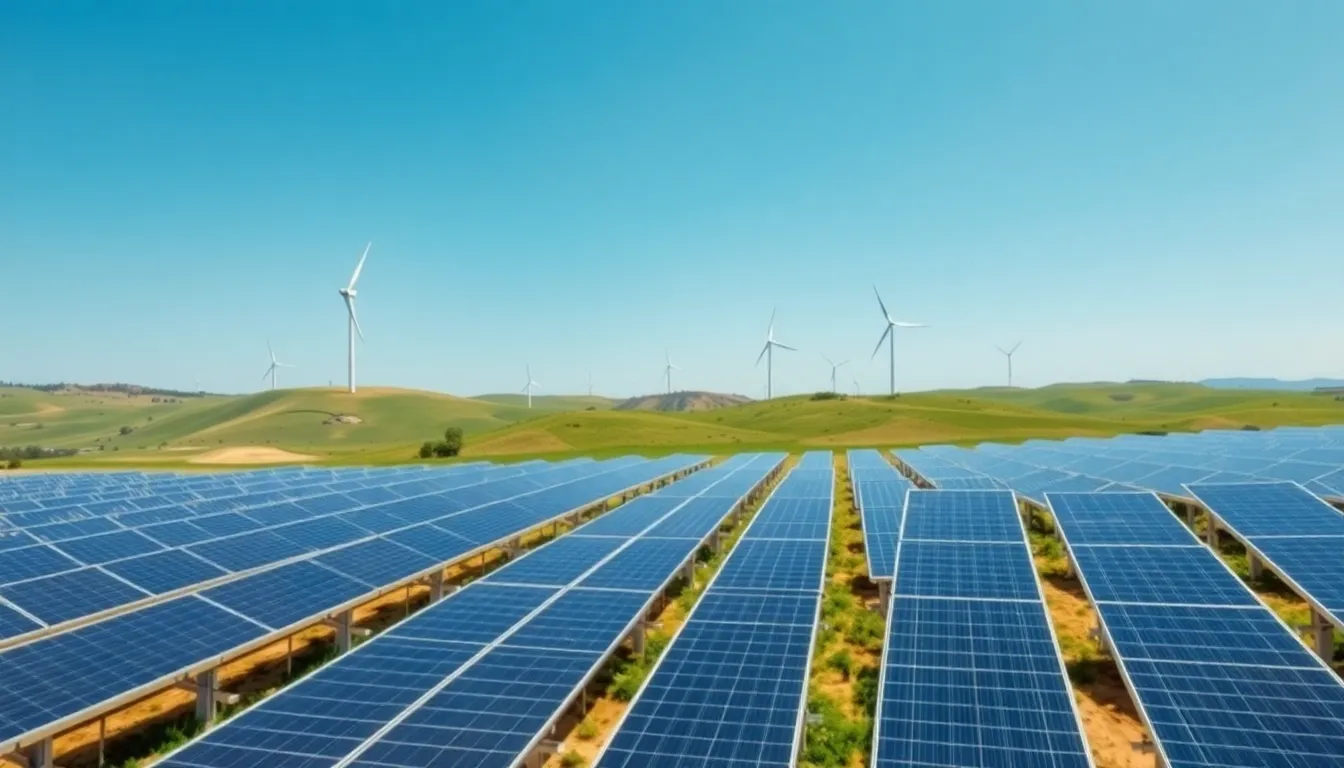Table of Contents
ToggleAs the planet warms at an alarming rate, the urgency to find effective solutions to global warming has never been greater. Rising temperatures, melting ice caps, and extreme weather events are just a few consequences of climate change that threaten ecosystems and human life alike. Tackling this complex issue requires innovative strategies and collective action across all sectors of society.
From renewable energy advancements to sustainable agriculture practices, numerous solutions are emerging to combat global warming. These approaches not only aim to reduce greenhouse gas emissions but also promote resilience in communities worldwide. By exploring and implementing these strategies, humanity can work towards a more sustainable future, ensuring a healthier planet for generations to come.
Understanding Global Warming
Global warming refers to the long-term increase in Earth’s average temperature due to human activities. Emissions of greenhouse gases contribute significantly to this trend, leading to far-reaching environmental impacts.
Causes of Global Warming
- Greenhouse Gas Emissions: Human activities produce carbon dioxide (CO2) and methane (CH4), primarily through fossil fuel combustion and industrial processes. In 2021, the global CO2 emissions from fossil fuels reached approximately 36.4 billion metric tons.
- Deforestation: Trees absorb CO2, so clearing forests reduces this natural carbon sink. The World Resources Institute reported that about 10 million hectares of forest are lost each year.
- Agriculture: Agricultural practices release greenhouse gases through livestock, rice production, and fertilizer use. It’s estimated that agriculture contributes about 14% of global greenhouse gas emissions.
- Land Use Changes: Modifications in land use, such as urban development and agriculture, further exacerbate climate change by disrupting ecosystems and carbon storage.
Effects on the Environment
- Rising Temperatures: Average global temperatures have increased by 1.1°C since the late 19th century. This rise affects weather patterns and habitats.
- Melting Ice Caps: Polar ice sheets and glaciers are losing mass at unprecedented rates. The National Snow and Ice Data Center indicated that Greenland lost roughly 279 billion tons of ice per year from 1993 to 2019.
- Ocean Acidification: Increased CO2 absorption by oceans leads to acidification, harming marine species. Ocean pH has declined by 0.1 units since the start of the Industrial Revolution.
- Extreme Weather Events: Increased frequency of hurricanes, droughts, and floods creates challenges for communities and ecosystems. The National Oceanic and Atmospheric Administration recorded 22 weather and climate disasters in 2020, each causing over $1 billion in damages.
By understanding these causes and effects, strategies to mitigate global warming can be developed more effectively.
Renewable Energy Sources

Renewable energy sources play a crucial role in mitigating global warming. They provide clean alternatives to fossil fuels, reducing greenhouse gas emissions significantly.
Solar Energy
Solar energy harnesses sunlight to generate electricity or heat. Photovoltaic cells convert sunlight into electricity, while solar thermal systems use sunlight to produce heat for residential and industrial applications. In 2020, the global solar energy capacity reached 773 gigawatts, contributing to about 10% of the world’s electricity. Countries like Germany, China, and the United States lead in solar energy production. Incentives such as tax credits and rebates further encourage solar adoption, making it a viable option for reducing carbon footprints.
Wind Energy
Wind energy captures the kinetic energy of wind through turbines to generate electricity. As of 2021, global wind energy capacity stood at approximately 743 gigawatts, powering millions of homes. The United States, China, and Germany dominate in wind energy installations. Offshore wind farms offer additional potential, with significantly higher energy output due to stronger and more consistent winds. Government policies and technological advancements, like improved turbine efficiency, enhance wind energy’s role in transitioning to a sustainable energy future.
Energy Efficiency Measures
Energy efficiency measures play a vital role in reducing energy consumption and mitigating global warming effects. Implementing these practices in both residential and industrial settings leads to significant reductions in greenhouse gas emissions.
Home Improvements
Home improvements focus on enhancing energy efficiency in residential spaces. Upgrading insulation reduces heat loss, which can decrease heating and cooling costs. Installing energy-efficient windows minimizes air leakage and improves comfort while reducing energy demands. Incorporating smart home technologies, like programmable thermostats, enables users to optimize heating and cooling schedules based on occupancy patterns. Additionally, adopting Energy Star-rated appliances offers substantial savings, as these devices consume less electricity, which contributes to lower overall power usage.
Industrial Innovations
Industrial innovations target energy efficiency within manufacturing processes and large facilities. Implementing combined heat and power systems (CHP) allows industrial plants to generate electricity and capture useful heat simultaneously, achieving efficiencies of up to 80%. Automating production lines through advanced technologies, such as the Internet of Things (IoT), enhances monitoring and control of energy use, leading to reduced waste. Incorporating energy management systems (EMS) further optimizes operations by analyzing consumption patterns and identifying opportunities for improvement. Transitioning to more energy-efficient machinery can also enhance performance while decreasing overall energy requirements.
Carbon Capture Technology
Carbon capture technology plays a crucial role in mitigating global warming by capturing carbon dioxide (CO2) emissions from various sources before they enter the atmosphere. It focuses on reducing greenhouse gas concentrations, offering a viable solution to combat climate change.
Mechanisms of Carbon Capture
Carbon capture technology employs several mechanisms to effectively sequester CO2.
- Post-combustion capture: This method extracts CO2 from flue gases released after fossil fuels are burned. Utilizing chemical solvents, it absorbs CO2 while allowing other gases to escape.
- Pre-combustion capture: This approach involves gasifying fuels before combustion. By converting fossil fuels into hydrogen and CO2, it captures CO2 before energy generation occurs.
- Oxy-fuel combustion: This process burns fossil fuels in an oxygen-rich environment. It produces a flue gas primarily composed of CO2 and water vapor, simplifying subsequent CO2 separation.
- Direct air capture: This innovative method extracts CO2 directly from the atmosphere using chemical reactions. It allows for the potential reduction of atmospheric CO2 concentrations, regardless of the emission source.
Current Applications
Carbon capture technology sees applications in various industries, showcasing its effectiveness in reducing emissions.
- Power generation: Power plants equipped with carbon capture systems significantly lower CO2 emissions, contributing to cleaner energy production. Facilities like the Petra Nova project in Texas capture over 90% of CO2 emissions from coal-fired power generation.
- Cement and steel manufacturing: These industries are major CO2 emitters. Technologies are being developed to integrate carbon capture into production processes, such as the Carbon Clean Solutions in cement production, which captures approximately 30% of emissions.
- Hydrogen production: Carbon capture aids in producing blue hydrogen, where natural gas is converted into hydrogen while capturing the byproduct CO2. This method reduces overall emissions and incorporates hydrogen as a clean energy source.
- Natural gas processing: Industries capture CO2 from natural gas to enhance recovery processes. In the North American shale gas sector, carbon capture helps minimize overall greenhouse gas emissions.
Carbon capture technology thus stands as a critical component in the broader strategy to address global warming, with mechanisms and applications that substantially reduce carbon emissions across various sectors.
Policy and Legislation
Policy and legislation play critical roles in addressing global warming through frameworks that govern emissions, renewable energy investment, and sustainable practices. Effective policies foster cooperation among nations and drive innovation in technology and practices to mitigate climate change.
International Agreements
International agreements serve as essential tools for nations to collaborate on reducing greenhouse gas emissions. The Paris Agreement, established in 2015, commits participating countries to limit global temperature rise to well below 2°C above pre-industrial levels, aiming for 1.5°C. As of 2022, 197 countries signed the agreement, demonstrating a unified commitment to combating global warming while establishing nationally determined contributions (NDCs) tailored to each country’s circumstances.
The Kyoto Protocol, adopted in 1997, marked the first legally binding international treaty that set emissions reduction targets for industrialized nations. Despite facing challenges, it laid the groundwork for subsequent agreements, pushing many countries to adopt carbon pricing and emissions trading systems.
Additionally, frameworks like the United Nations Framework Convention on Climate Change (UNFCCC) facilitate ongoing discussions, progress reviews, and financial support for developing nations. These international agreements create a shared responsibility and framework for nations to address global warming collectively.
National Initiatives
National initiatives encompass various policies and programs designed to meet climate goals and reduce emissions. Countries such as the United States, through its Clean Power Plan, aim to lower carbon pollution from power plants. The plan emphasizes a transition from fossil fuels toward renewable energy sources, enhancing overall energy efficiency.
In Europe, the European Green Deal outlines ambitious targets to achieve net-zero greenhouse gas emissions by 2050. This initiative includes investments in clean technologies, sustainable industry practices, and enhancing environmental legislation to guide member states in implementing climate-friendly solutions.
Furthermore, numerous countries have developed national climate action plans that detail strategies for achieving emission reduction targets. Nations like Canada and Japan have invested in innovative technologies and infrastructure improvements to transition towards low-carbon economies, granting incentives to businesses and consumers for adopting renewable energy solutions.
These national initiatives demonstrate a comprehensive approach to combating global warming, showcasing the integration of policy, technology, and investment at various levels of governance.
Community-Based Solutions
Community-based solutions play a vital role in addressing global warming by fostering local engagement and collective action. These initiatives empower individuals and communities to implement effective strategies tailored to their unique environments.
Grassroots Movements
Grassroots movements significantly impact climate action by mobilizing community members toward sustainability goals. Examples include local groups organizing tree planting events, beach cleanups, and community gardens. These movements promote awareness of global warming, encourage sustainable practices, and foster a sense of ownership among participants. Organizations such as 350.org and Citizens’ Climate Lobby exemplify grassroots efforts to advocate for stronger climate policies and engage citizens in climate education, driving broader societal change.
Educational Programs
Educational programs serve as essential tools for informing communities about global warming and promoting sustainable practices. Schools, non-profits, and local governments often collaborate to develop workshops, seminars, and interactive activities. Topics range from renewable energy technologies to waste reduction techniques. According to a 2020 survey, around 72% of Americans believe environmental education enhances community engagement in sustainability efforts. Programs like Climate Generation and the Alliance for Climate Education provide resources and training for educators, empowering them to teach students about climate science and advocacy, fostering an informed and proactive generation.
Addressing global warming requires a multifaceted approach that combines innovative technologies with community engagement. By investing in renewable energy and enhancing energy efficiency, society can significantly reduce greenhouse gas emissions. Carbon capture technologies further contribute to this effort by mitigating emissions from various industries.
Policy frameworks and international agreements play a vital role in guiding these initiatives, ensuring that nations work together towards a sustainable future. Grassroots movements and educational programs empower communities to take action, fostering a culture of sustainability.
Collective efforts across all sectors are essential for creating lasting change. With commitment and collaboration, it’s possible to pave the way for a healthier planet for future generations.







